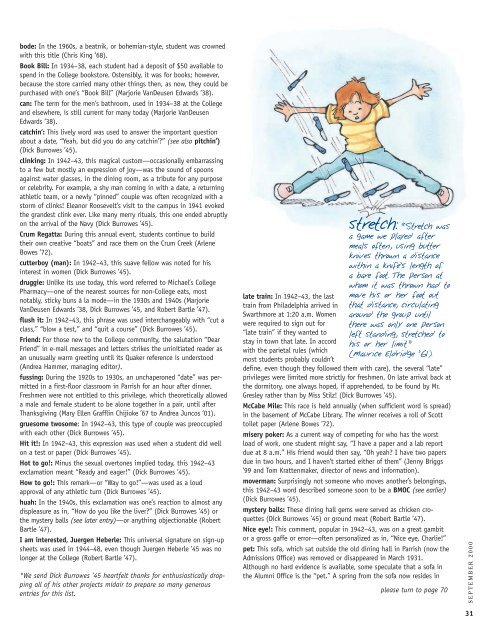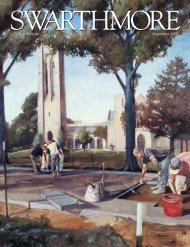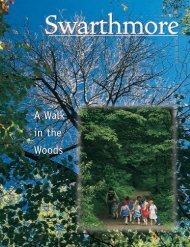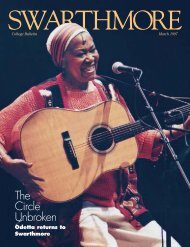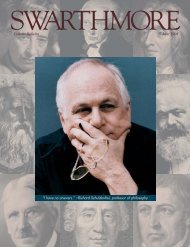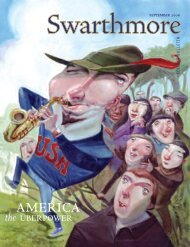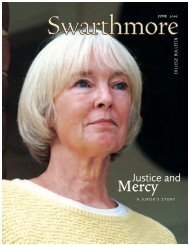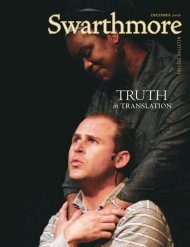SWARTHMORE
Swarthmore College Bulletin (September 2000) - ITS
Swarthmore College Bulletin (September 2000) - ITS
- No tags were found...
Create successful ePaper yourself
Turn your PDF publications into a flip-book with our unique Google optimized e-Paper software.
ode: In the 1960s, a beatnik, or bohemian-style, student was crownedwith this title (Chris King ’68).Book Bill: In 1934–38, each student had a deposit of $50 available tospend in the College bookstore. Ostensibly, it was for books; however,because the store carried many other things then, as now, they could bepurchased with one’s “Book Bill” (Marjorie VanDeusen Edwards ’38).can: The term for the men’s bathroom, used in 1934–38 at the Collegeand elsewhere, is still current for many today (Marjorie VanDeusenEdwards ’38).catchin’: This lively word was used to answer the important questionabout a date, “Yeah, but did you do any catchin’?” (see also pitchin’)(Dick Burrowes ’45).clinking: In 1942–43, this magical custom—occasionally embarrassingto a few but mostly an expression of joy—was the sound of spoonsagainst water glasses, in the dining room, as a tribute for any purposeor celebrity. For example, a shy man coming in with a date, a returningathletic team, or a newly “pinned” couple was often recognized with astorm of clinks! Eleanor Roosevelt’s visit to the campus in 1941 evokedthe grandest clink ever. Like many merry rituals, this one ended abruptlyon the arrival of the Navy (Dick Burrowes ’45).Crum Regatta: During this annual event, students continue to buildtheir own creative “boats” and race them on the Crum Creek (ArleneBowes ’72).cutterboy (man): In 1942–43, this suave fellow was noted for hisinterest in women (Dick Burrowes ’45).druggie: Unlike its use today, this word referred to Michael’s CollegePharmacy—one of the nearest sources for non-College eats, mostnotably, sticky buns à la mode—in the 1930s and 1940s (MarjorieVanDeusen Edwards ’38, Dick Burrowes ’45, and Robert Bartle ’47).flush it: In 1942–43, this phrase was used interchangeably with “cut aclass,” “blow a test,” and “quit a course” (Dick Burrowes ’45).Friend: For those new to the College community, the salutation “DearFriend” in e-mail messages and letters strikes the uninitiated reader asan unusually warm greeting until its Quaker reference is understood(Andrea Hammer, managing editor).fussing: During the 1920s to 1930s, an unchaperoned “date” was permittedin a first-floor classroom in Parrish for an hour after dinner.Freshmen were not entitled to this privilege, which theoretically alloweda male and female student to be alone together in a pair, until afterThanksgiving (Mary Ellen Grafflin Chijioke ’67 to Andrea Juncos ’01).gruesome twosome: In 1942–43, this type of couple was preoccupiedwith each other (Dick Burrowes ’45).Hit it!: In 1942–43, this expression was used when a student did wellon a test or paper (Dick Burrowes ’45).Hot to go!: Minus the sexual overtones implied today, this 1942–43exclamation meant “Ready and eager!” (Dick Burrowes ’45).How to go!: This remark—or “Way to go!”—was used as a loudapproval of any athletic turn (Dick Burrowes ’45).huah: In the 1940s, this exclamation was one’s reaction to almost anydispleasure as in, “How do you like the liver?” (Dick Burrowes ’45) orthe mystery balls (see later entry)—or anything objectionable (RobertBartle ’47).I am interested, Juergen Heberle: This universal signature on sign-upsheets was used in 1944–48, even though Juergen Heberle ’45 was nolonger at the College (Robert Bartle ’47).*We send Dick Burrowes ’45 heartfelt thanks for enthusiastically droppingall of his other projects midair to prepare so many generousentries for this list.late train: In 1942–43, the lasttrain from Philadelphia arrived inSwarthmore at 1:20 a.m. Womenwere required to sign out for“late train” if they wanted tostay in town that late. In accordwith the parietal rules (whichmost students probably couldn’tstretch: “Stretch wasa game we played aftermeals often, using butterknives thrown a distancewithin a knife’s length ofa bare foot. The person atwhom it was thrown had tomove his or her foot outthat distance, circulatingaround the group untilthere was only one personleft standing, stretched tohis or her limit ”(Maurice Eldridge ’61).define, even though they followed them with care), the several “late”privileges were limited more strictly for freshmen. On late arrival back atthe dormitory, one always hoped, if apprehended, to be found by Mr.Gresley rather than by Miss Stilz! (Dick Burrowes ’45).McCabe Mile: This race is held annually (when sufficient word is spread)in the basement of McCabe Library. The winner receives a roll of Scotttoilet paper (Arlene Bowes ’72).misery poker: As a current way of competing for who has the worstload of work, one student might say, “I have a paper and a lab reportdue at 8 a.m.” His friend would then say, “Oh yeah? I have two papersdue in two hours, and I haven’t started either of them” (Jenny Briggs’99 and Tom Krattenmaker, director of news and information).moverman: Surprisingly not someone who moves another’s belongings,this 1942–43 word described someone soon to be a BMOC (see earlier)(Dick Burrowes ’45).mystery balls: These dining hall gems were served as chicken croquettes(Dick Burrowes ’45) or ground meat (Robert Bartle ’47).Nice eye!: This comment, popular in 1942–43, was on a great gambitor a gross gaffe or error—often personalized as in, “Nice eye, Charlie!”pet: This sofa, which sat outside the old dining hall in Parrish (now theAdmissions Office) was removed or disappeared in March 1931.Although no hard evidence is available, some speculate that a sofa inthe Alumni Office is the “pet.” A spring from the sofa now resides inplease turn to page 70S E P T E M B E R 2 0 0 031


